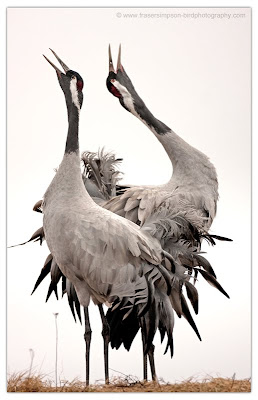 We often read of Crane vocalisations described as ‘bugling’ or ‘trumpeting’ but I recently found a paper in the Journal of Comparative Physiology by Gaunt, A.S. et al (1987) that suggests that rather than comparison with a wind instrument, a better analogy would be with a stringed instrument such as a violin. Through experiments involving surgery of the trachea, or wind-pipe (I wonder if this sort of work still occurs today?) they found that the syrinx (the avian voice box) works like the ‘strings’ resting on the ‘bridge’ of an instrument, in this case the crane’s trachea (acting as a resonator), with the vibrations transferred to the sternum (breast bone). The sound is further amplified as the sternum is connected to a system of air sacs. Looking at pictures of the anatomy of the crane trachea, I had no idea it was so coiled.
We often read of Crane vocalisations described as ‘bugling’ or ‘trumpeting’ but I recently found a paper in the Journal of Comparative Physiology by Gaunt, A.S. et al (1987) that suggests that rather than comparison with a wind instrument, a better analogy would be with a stringed instrument such as a violin. Through experiments involving surgery of the trachea, or wind-pipe (I wonder if this sort of work still occurs today?) they found that the syrinx (the avian voice box) works like the ‘strings’ resting on the ‘bridge’ of an instrument, in this case the crane’s trachea (acting as a resonator), with the vibrations transferred to the sternum (breast bone). The sound is further amplified as the sternum is connected to a system of air sacs. Looking at pictures of the anatomy of the crane trachea, I had no idea it was so coiled.I recorded the unison calls from a pair of Eurasian Cranes (Grus grus) in Sweden last year and if you listen to the sound file and look at the sonogram you can hear the harmonic sounds produced from both sexes during display. The male utters the single, longer call (lowest, or fundamental, harmonic between 0.65 - 0.90 kHz) lasting around 0.6 seconds with the female duetting with two shorter, slightly higher-pitched calls (lowest harmonic 0.95 - 1.15 kHz) lasting around 0.15 seconds. I was in a small hide just metres away from the pair and the loudness and intensity of crane vocals at this range was amazing. Quite different is hearing a pair at long range, echoing over a northern bog when the sound becomes evocative and beautiful… and I’ll post more on this later.


3 comments:
Very cool, neat to compare these to our Sandhill Cranes. And the pics are GREAT!
Great photos!
I was at Hornborga Lake during the weekend, 14400 cranes, it was amazing, even though the weather wasn't that great.
Hi Bilal, sounds amazing! I didn't make it this year but hope to be back in 2012.
Post a Comment